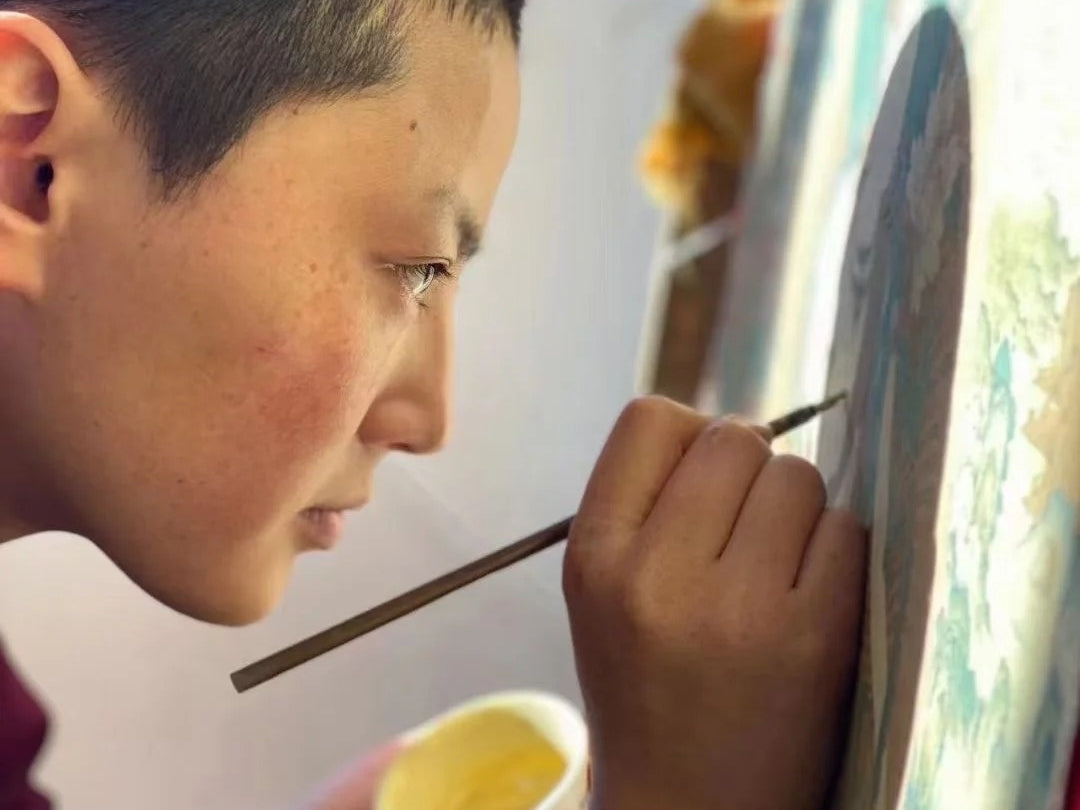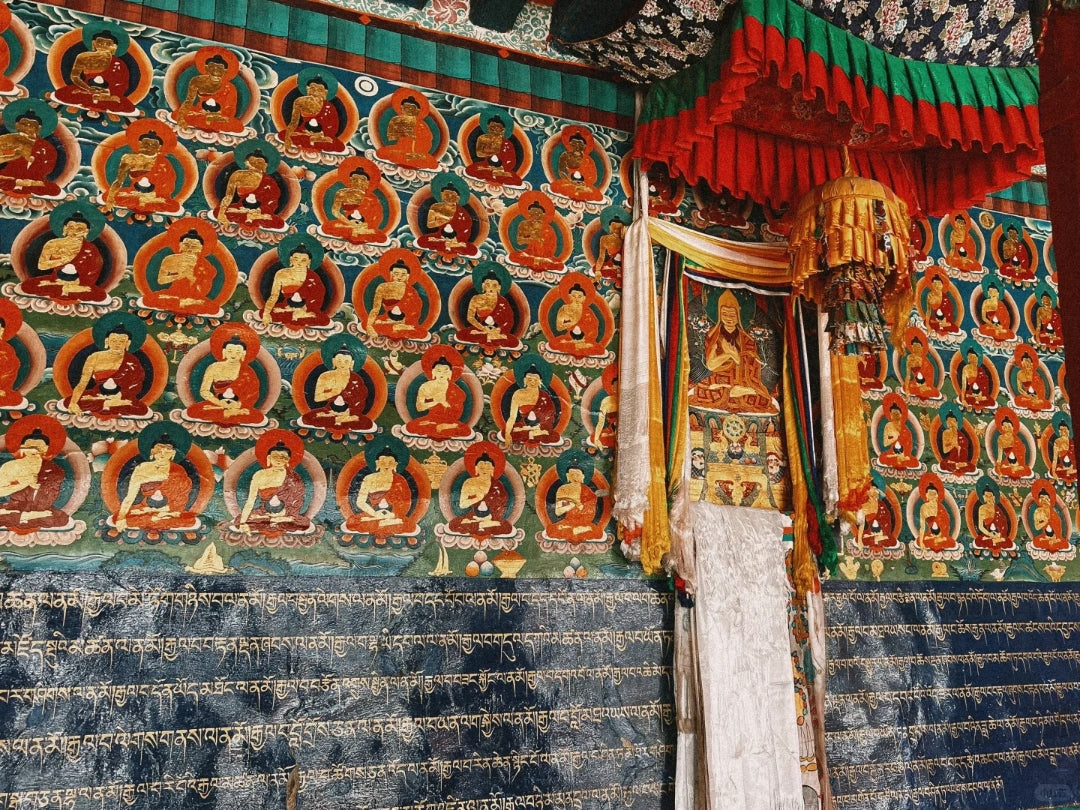Across Tibetan lands, devotion isn’t only directed at great Buddhas and bodhisattvas. Many villages and valleys maintain living relationships with local patron deities — spirits tied to a particular mountain, river, pasture, or village — who are thought to govern weather, fertility, safety, and everyday fortune. These place-based figures often sit alongside pan-Buddhist icons in household shrines and community rituals, and they remain a vital, practical part of local life. This article explores who these guardian spirits are, how they differ from canonical Buddhist figures, how villagers make and use small amulets and framed Thangka icons for them, and respectful ways diaspora readers can learn and show support.

Who are local patron deities?
Local patron deities are diverse in form and origin. They may be:
-
Yul Lha (land gods): Spirits associated with a specific mountain, valley, or plot of land. Communities appeal to yul lha for grazing rights, safe passage, and protection from natural hazards.
-
Lu or water spirits: Guardians of rivers, springs, and lakes; rituals to these spirits are offered to ensure clean water, abundant fish, or benign weather.
-
Peak patrons and mountain gods: Major peaks often have a named guardian spirit whose favor is sought before pilgrimages or mountaineering expeditions.
-
Ancestral or clan tutelaries: Local families sometimes venerate an ancestral protector unique to their lineage.
-
Syncretic figures: In many places, older Bon or folk gods were incorporated into Buddhist practice, becoming wrathful protectors or local manifestations of broader deities.
These figures are often referred to with local terms and may be honored with small shrines at the village edge, painted images, or temporary festival constructions.

How local patrons differ from pan-Buddhist figures
Pan-Buddhist deities (Avalokiteshvara, Tara, Medicine Buddha) carry broad doctrinal meanings shared across regions and lineages. Local patron deities, by contrast, are:
-
Territorial: Their power is usually tied to a place and may not extend beyond it.
-
Pragmatic: Their concerns are immediate — good pasture, a bountiful harvest, protection from avalanches — rather than explicitly soteriological.
-
Mutable in identity: A patron might be an older nature spirit adapted into Buddhist rituals, or a deified ancestor, or even a protective emanation of a Buddhist figure for that locale.
-
Maintained by lay communities: While monks may be involved, keeping a patron deity placated often falls to village leaders, families, or lay ritualists.
That fluid, local character is precisely why these gods remain relevant: they answer the day-to-day questions of survival and social order.

How communities keep patron deities alive
Local devotion is sustained through routine, ritual, and craft. Common practices include:
-
Seasonal offerings and festivals: At planting or before winter, villages make offerings—food, butter lamps, incense, or livestock sacrifices (where practiced)—to secure the deity’s favor. Festivals often combine masked dances, music, and the display of local Thangka banners.
-
Petitionary rituals: If a household faces illness or misfortune, families may organize a small ritual (puja) led by a lama or ritual specialist to appease the local guardian.
-
Sacred markers: Cairns, mani walls, small chortens, or painted stones mark the territory and remind passersby to show respect.
-
Amulets and framed icons: Artisans create small metal amulets, carved stones, or modest painted Thangka images that carry the deity’s likeness. These objects are worn, kept in homes, or hung in animal shelters and fields. They function as portable protection and a visual focus for devotion.
-
Oral memory and story: Storytelling keeps the deity’s origin stories and taboos alive across generations.
These practices are communal, adaptive, and often informal—less about rigid dogma and more about reciprocal relationship.
Craft and commerce: making small amulets and Thangka icons
Local craftspeople produce many of the devotional objects tied to patron deities:
-
Metal amulets: Cast in brass or simple silver alloys, stamped or hand-incised with the deity’s image or a protective mantra. They’re compact, affordable, and easy to distribute at festivals.
-
Framed mini-Thangkas: Artists paint small devotional images on cotton or silk to be hung in homes or kept in shrine boxes (gawu). These miniaturized images allow households to keep their patron’s presence close.
-
Portable shrine boxes (gawu): Often handmade from brass or wood and sometimes painted, gawus protect small icons or relics and function as personal altars.
Artisans making these items are vital carriers of style and meaning; their choices about iconography, material, and inscription shape how a deity is experienced locally.
How diaspora readers can learn respectfully
For readers outside Tibet who want to understand or honor local patron practices, here are thoughtful approaches:
-
Learn from local communities and teachers. Connect with Tibetan cultural centers, monastic communities, or diaspora elders. Firsthand learning prevents oversimplification.
-
Listen before photographing or sharing. Some rituals and objects are private or sacred; ask permission and follow guidance on what may be photographed or posted online.
-
Support artisans and ethical sellers. Buy amulets, Thangkas, or gawus from vendors who can identify makers and explain provenance—this sustains traditional craft.
-
Avoid commodifying sacred practices. Refrain from trivializing rituals as exotic trends. If you wear an amulet, learn its meaning and treat it with care.
-
Honor context in display. If you display a mini-Thangka or amulet at home, keep it in a clean, elevated place and be mindful of ritual etiquette (for example, not placing sacred images where they could be disrespected).
Why these practices matter today
Local patron deities keep community life connected to place, memory, and mutual care. They knit together seasonal rhythms, ecological knowledge, and moral responsibility. Even as modern pressures reshape Himalayan life—migration, tourism, climate change—villages adapt by reworking offerings, making portable icons for migrants, and using craft markets to support rituals financially.
For anyone curious about the god of tibet local deity tradition, the living scene is an invitation: observe with humility, prioritize local voices, and remember that these figures belong first and foremost to the people who keep them.





